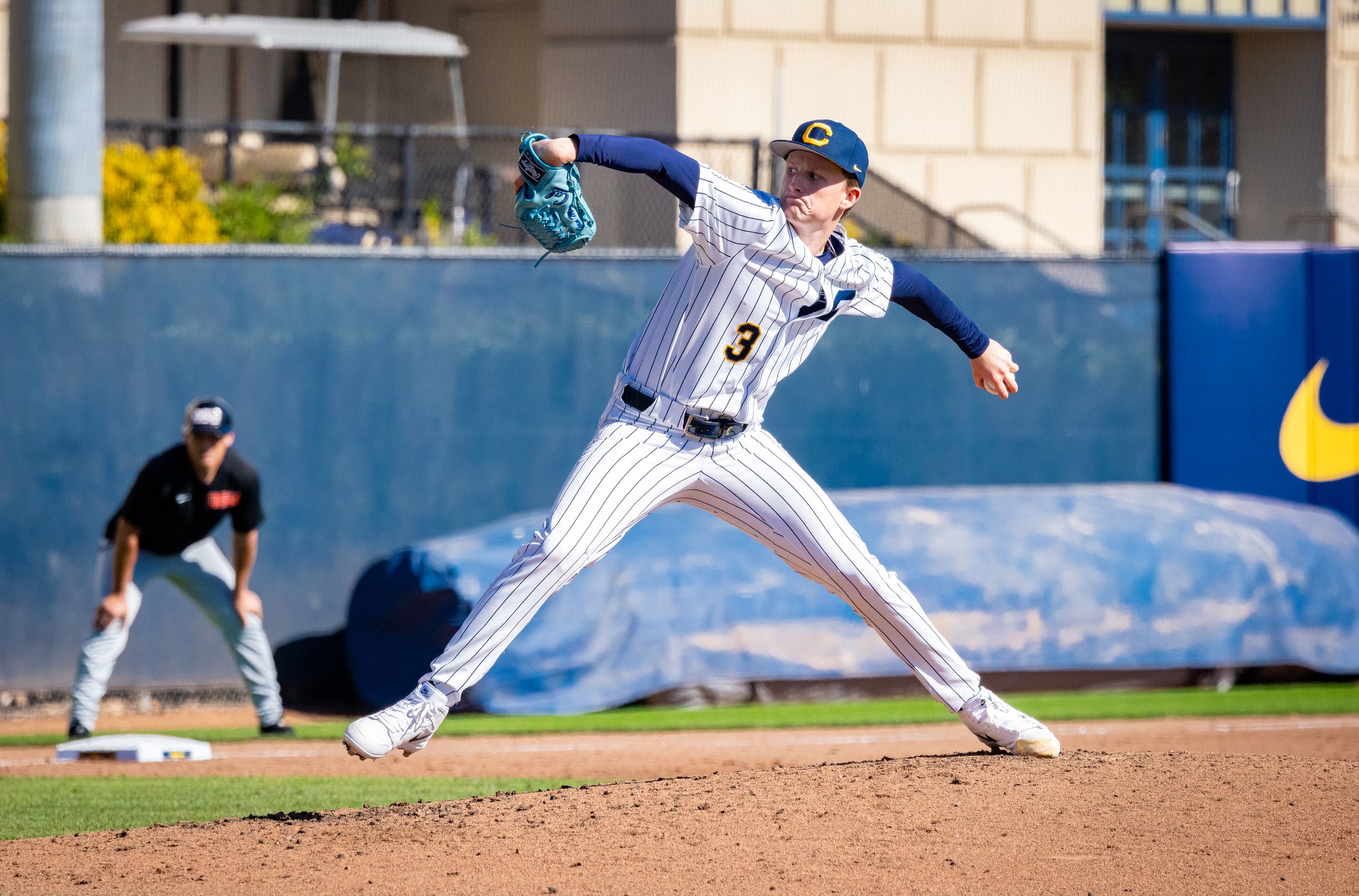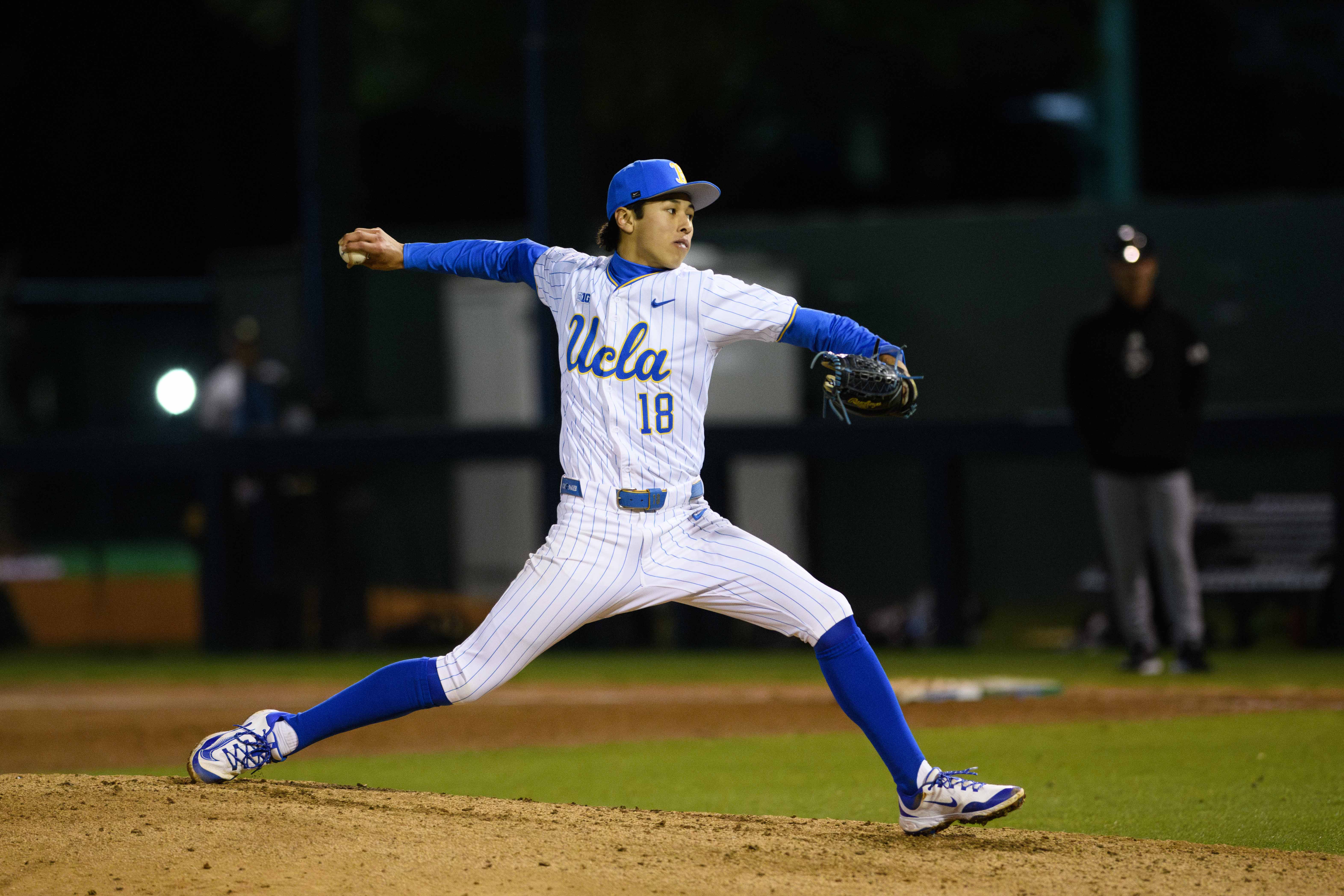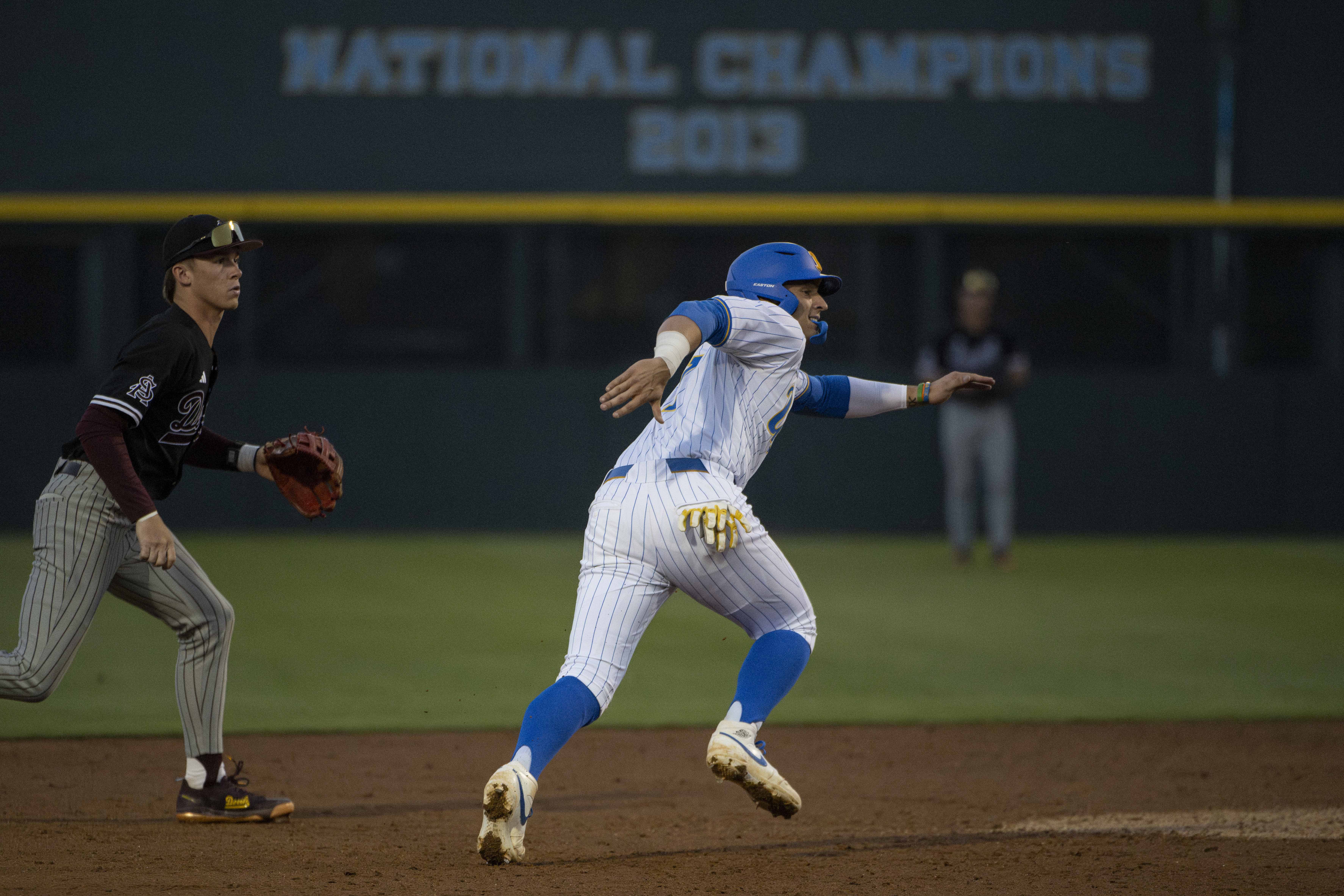Injury-ridden seasons finally behind UCLA baseball, 4 pitchers back on the mound
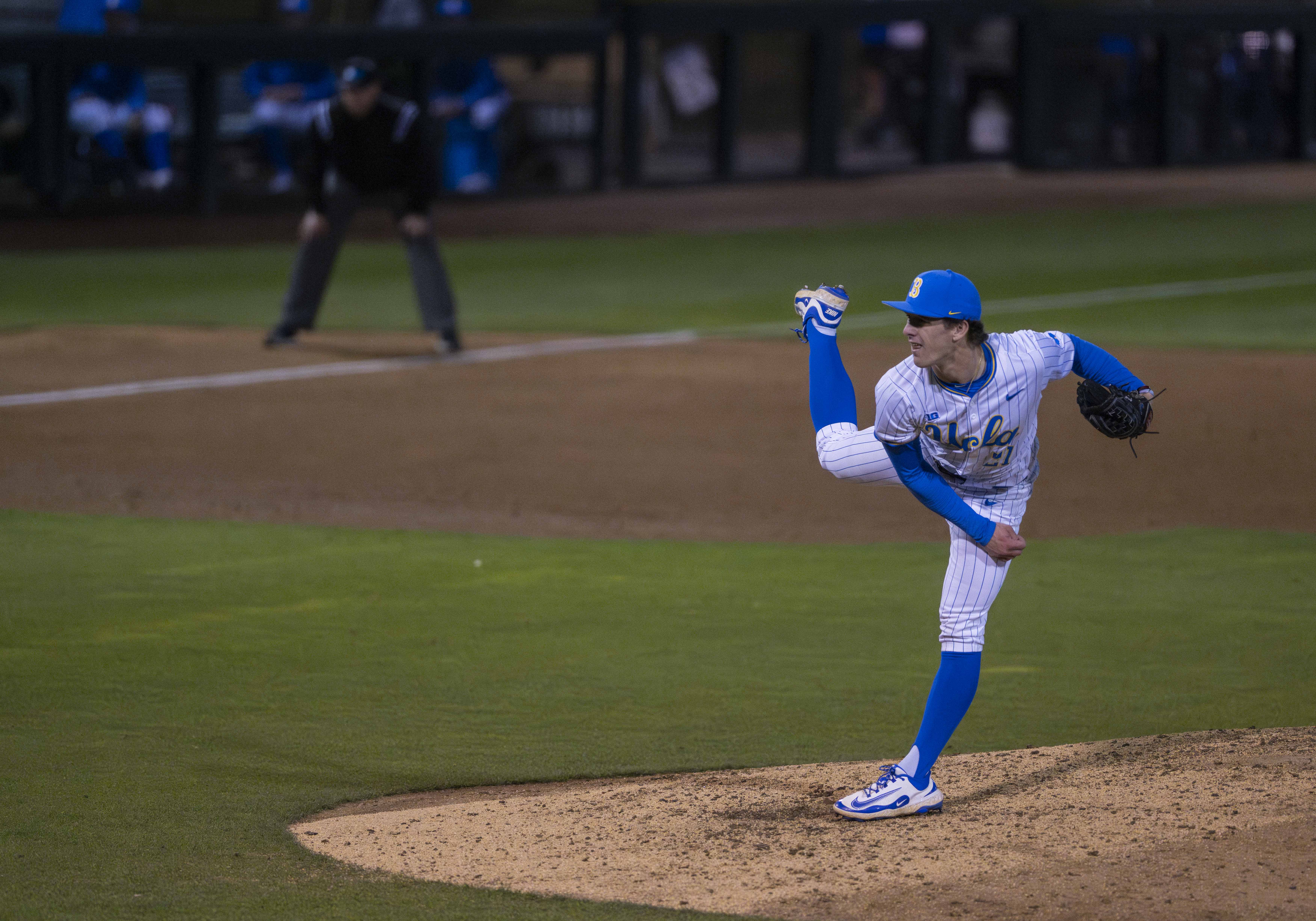
Redshirt junior right-hander Josh Alger follows through on his motion at Jackie Robinson Stadium. After a myriad of injuries kept him off the mound since his senior year of high school, Alger had to wait till his fourth season at UCLA to make his collegiate debut, which came Feb. 15. (Renee Rubanowitz/Daily Bruin)
By Kai Dizon
April 20, 2025 11:27 p.m.
Josh Alger came in to shut the door in the Bruins’ 18-2 victory Feb. 15.
But it was probably unclear for many in the stands why sophomore catcher Blake Balsz gave the redshirt junior right-hander a long embrace – or why past and present Bruins flooded social media with words for Alger – after a routine relief appearance in an early-season blowout.
The truth is that injuries had kept Alger off the mound through his first three seasons in Westwood. 2025 is the first year he’s been healthy since suffering a knee injury in high school, with that inning in February marking his collegiate debut.
“His first outing – I was terrified,” said Kaitlyn Gustafson, the team’s athletic trainer. “Not that he’d get reinjured, but it was more of a nervous excitement like, ‘Hey, I know … the four-plus years of work that this kid has put to get back.’”
Alger’s story, though, is just one of many.
After two injury-ridden seasons that stretched UCLA baseball’s pitching staff thin, coach John Savage said four veteran arms – Alger, junior right-hander Jack O’Connor, redshirt sophomore southpaw Chris Grothues and redshirt junior James Hepp – are healthy and back on the mound.
“We were really beat up last year,” Savage said. “We have much more health this year. We like our inventory of pitchers. … In terms of training our guys, arm care and maintaining their health, we feel like we’re in good hands and we have good training methods.”
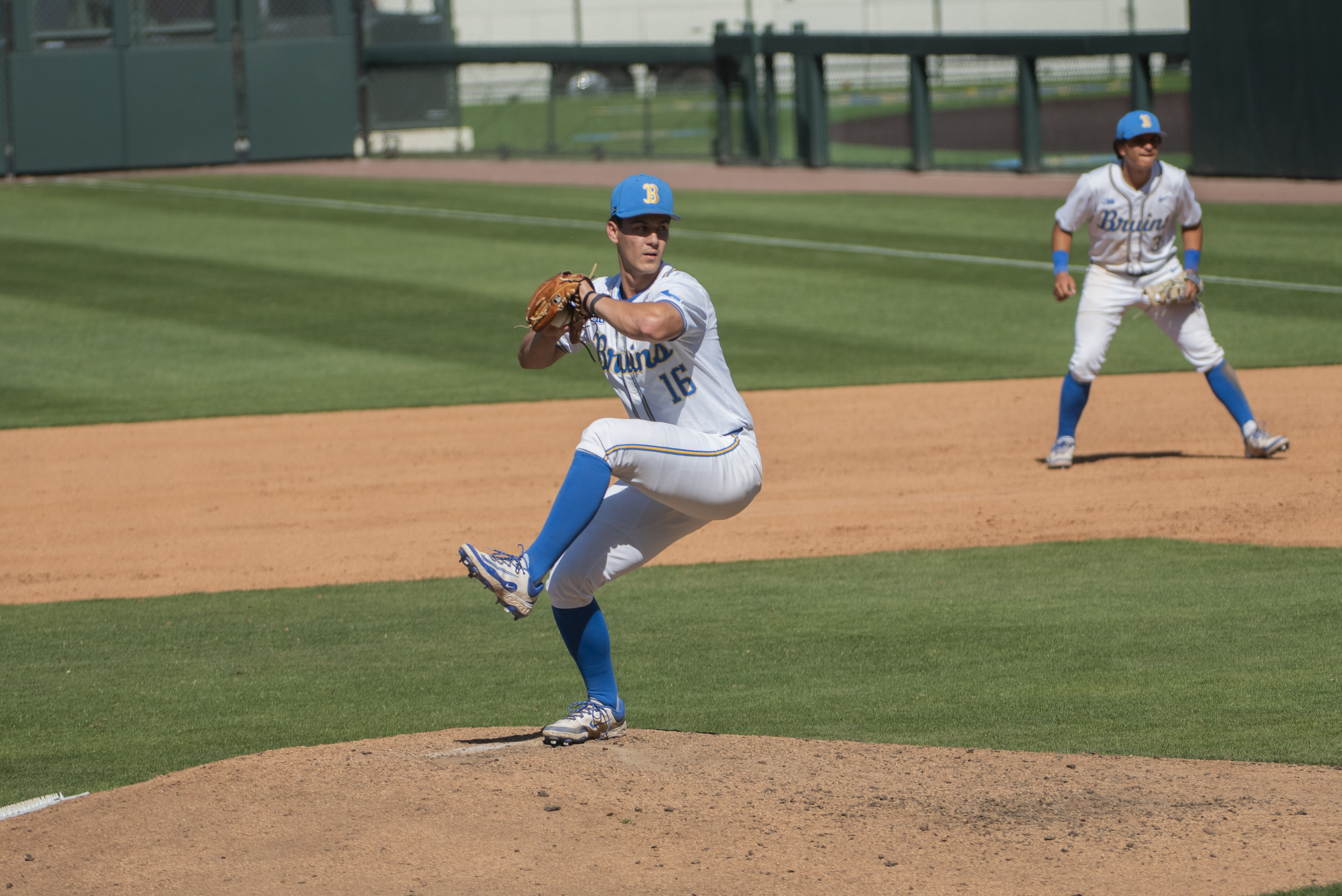
(Max Zhang/Daily Bruin)
O’Connor made his collegiate debut a day before Alger and has since become the Bruins’ setup man. The junior owns a 1.56 ERA and 1.10 WHIP across 17.1 innings this season after undergoing Tommy John surgery – a ligament reconstruction procedure in the elbow – two years ago, which was followed by a second arm surgery.
The right-hander began throwing in May and has steadily built from there while working primarily with Dr. Alanna Salituro, the squad’s physical therapist.
“I want to be classified as a Bruin pitcher, and the dream’s come true,” O’Connor said. “I’m just taking pitch by pitch, taking in the moment and it’s been going pretty well so far.”
O’Connor recorded his first collegiate save March 29 against Purdue, when he entered the ninth with two runners on base before recording three-straight outs in UCLA’s 13-12 victory.
With Grothues out for the entirety of the 2024 season, Savage had to turn to a pair of club baseball walk-ons for left-handed pitching. But in 2025, the redshirt sophomore has emerged as a high-leverage relief option.
The southpaw also underwent Tommy John surgery in fall 2023 and began throwing in April 2024, but a facial surgery following a non-athletic injury in October 2024 put his rehab on hold. Grothues pitched for the first time in nearly two years Feb. 22 but again had to miss time after a meniscus injury sidelined him in mid-March.
“He had to get almost like a third surgery throughout this whole rehab process,” Gustafson said. “And then that involved, again, a little bit of a shutdown, rehabbing another body part while still maintaining the strength in his arm and then restarting throwing from that.”
In his first appearance since the knee injury, Grothues tossed two perfect innings against Washington on April 11 – and two days later, he was brought into a bases-loaded, one-out situation, where he struck out back-to-back hitters to escape unscathed.
“After coming back from injury like Tommy John and then another setback, like a meniscus tear, I just told myself, ‘I’m not going to worry about what happens, I’m going to just trust the process, trust the coaches and then just go pitch to pitch.’”
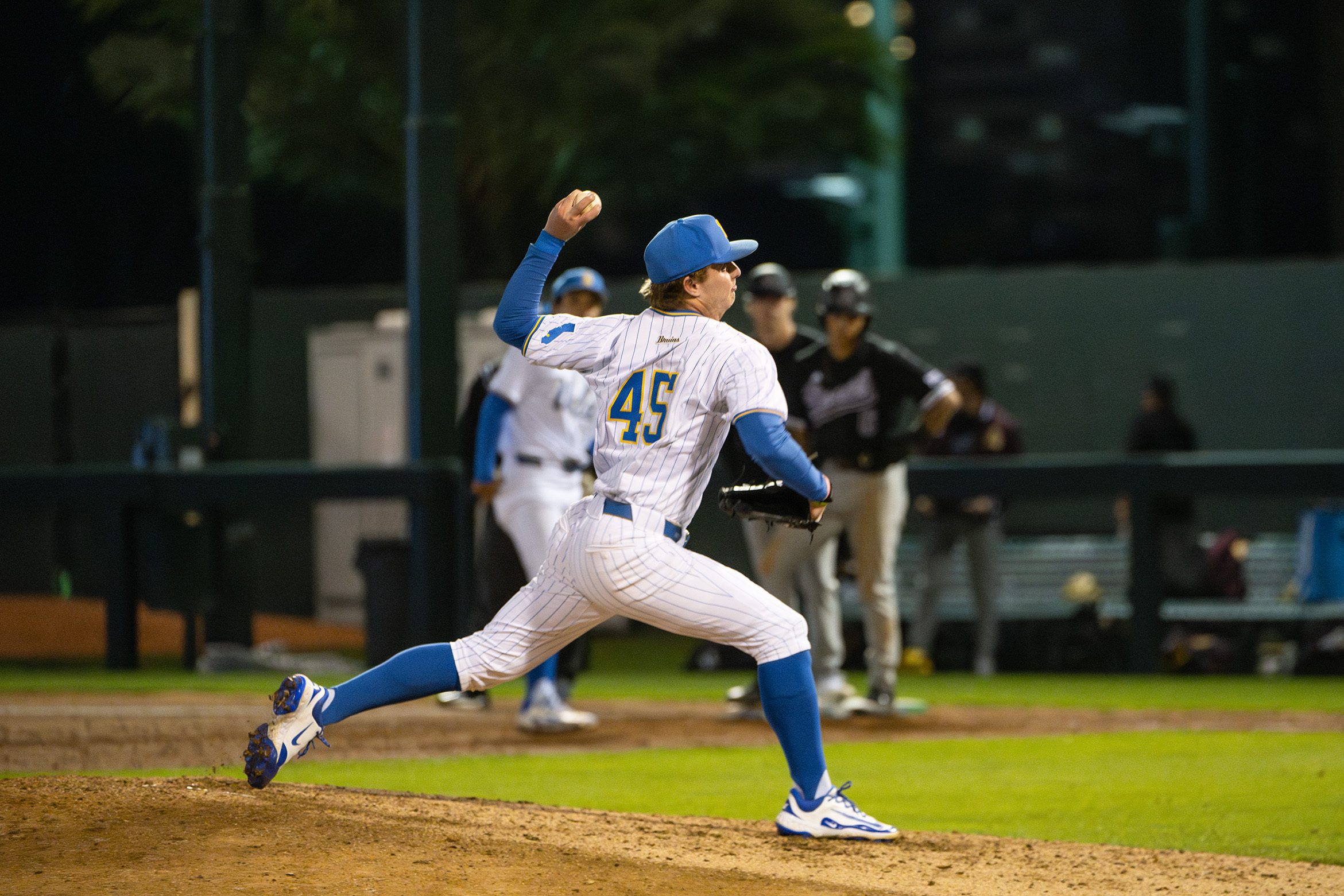
Hepp was the latest of the bunch to make his 2025 debut, tossing a scoreless inning where he struck out a pair Tuesday against No. 6 Oregon State – his first appearance since May 2023.
The right-hander tried to avoid surgery with non-operative rehab but ultimately underwent an operation for his shoulder in April. Gustafson said Hepp was uncomfortable early in the rehab process, struggling with his command, but has steadily improved and remained committed to the process along with his teammates.
“Had a lot of support from them, so just really happy to be back,” Hepp said. “I like playing baseball – and especially against a good team like that.”
Hepp will be limited by the frequency of his appearances and his pitch count per outing in the meantime but is continuing to build his strength back up.
Alger had the longest road back to the mound – beginning his senior year of high school – and experienced a flurry of setbacks throughout but never quit. Since his knee surgery, Alger had two operations done on his shoulder and one on his elbow, the most recent in January 2024.
“Josh could have easily been like, ‘Hey, this is my fourth surgery.’ I wouldn’t be shocked if anyone would want to walk away at that point because he hadn’t even everput on a Bruin uniform – hadn’t gotten in game,” Gustafson said. “Man, this kid put in probably more work than anyone on the team, and he worked with us again throughout his entire process. Would spend like four hours a day with us.”
Alger has pitched 10 innings this year, recording his first win April 8 over Long Beach State.
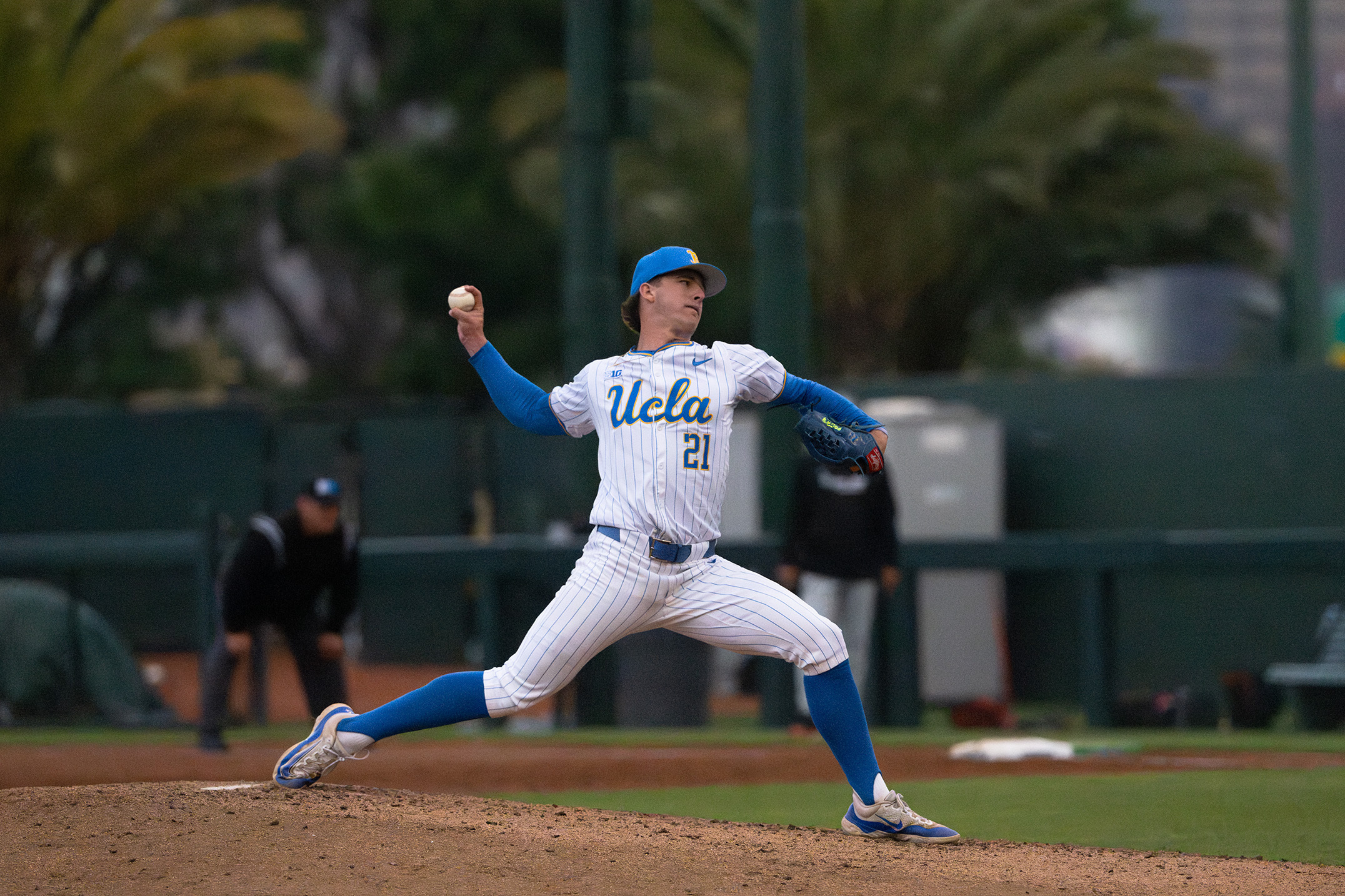
The four bonded with each other throughout their intertwined rehab processes, especially over the summer – where the group would spend at least three hours a day together – making the comeback less daunting, less boring and more fun.
“It’s a huge core group,” O’Connor said. “We need each other more than anything because the physical therapy grind is real. It’s a mental toll, and we just keep uplifting each other. It’s pretty fun, too, in the PT room. We try to keep it loose but also get our work in.”
Gustafson added that many are throwing harder than they did before their injuries.
Coincidentally, the season where many Bruins have found their ways back to the field is just Gustafson’s first with the team. While she’s spent five years at UCLA Athletics, she joined forces with baseball over the summer.
And despite working with upper extremity sports her entire career – and previously working with softball players – baseball pitchers posed a learning curve.
“As far as position player throwing, that’s really not anything different,” Gustafson said. “The big thing with me was working through pitching and programming throwing progressions for our pitchers but also getting to understand their techniques.”
Gustafson is joining a sport amid a pitching injury epidemic – affecting both players in the professional ranks and children playing travel ball –with no end in sight.
UCLA junior right-hander Finn McIlroy – a weekend starter in 2024 – hasn’t pitched since March 9, 2024, and underwent Tommy John surgery this past March.
Gerrit Cole – arguably the most famous Bruin since Jackie Robinson – will miss the 2025 MLB season with Tommy John.
And baseball’s biggest star – Shohei Ohtani, the modern-day Babe Ruth – hasn’t pitched since 2023 due to elbow injuries.
“It’s all about velocity,” said Savage, who himself had his playing career derailed by arm injuries. “A lot of guys are throwing really heavy velocity, hard-breaking balls. Every time they throw, there’s a radar going on them. … Over time, a lot of the new training regimens have been hurtful throughout the country. … High school and summer use and 12 months pitching and there’s a lot of different boxes youcan check on why there’s so many injuries.”
And Gustafson knows there’s no easy solution.
“We’re not going to tell kids, ‘Hey, don’t throw as hard,’” Gustafson said.
However, that doesn’t mean there aren’t ways injuries can be prevented. There may be ways a pitcher can be shut down for a couple of months – and put on an individualized arm-care plan – before they throw a pitch that sidelines them for over a year, or ends their career altogether.
Gustafson said Bruin pitchers are tested in September – once they get back to campus – for the strength and flexibility in their shoulder, hip, back, ankle and forearm.
“What research shows is the strength and numbers that collegiate baseball players need to be at,” Gustafson said. “If they’re not there, then they get put on a three-day week maintenance program, whether that is we’re adding stuff into the weight room, or they’re coming up into the training room or they’re doing all this at the field. It’s pre-programmed to meet their individual needs for that.”
Players are retested in December and January to see how their mobility and stamina have developed just ahead of the season.
While players are rewarded for the speed of their fastballs or the movement on their sweepers, prioritizing strength and recovery between outings might lead to a healthier game overall.
“When we test the guys like the pre-test and post-test, and they’re able to see how much stronger they’re getting, and they understand, like, ‘Hey, I’m able to either I feel better when I throw or I’m not as fatigued after my outings,’” Gustafson said. “That really helps with some of that buy-in. And I also see that they’re healthier and they feel better.”
However, despite how heartwarming comeback stories can be, it may seem wrong that baseball almost demands pitchers sacrifice their physical well-being for a chance at chasing their dreams.
While arm injuries may no longer be the career-ending sentence they once were – largely thanks to people like Gustafson and Salituro – it continues to seem like something about the sport needs to change.
“Unless we get away from throwing as hard as you can every single pitch, as much spin as you can every single pitch,” Gustafson said. “I don’t know if there’s a magical answer.”


